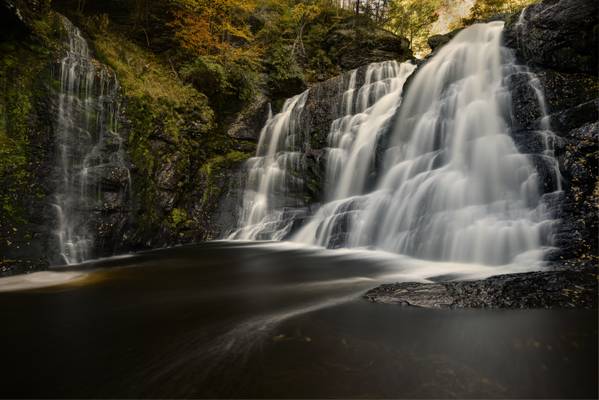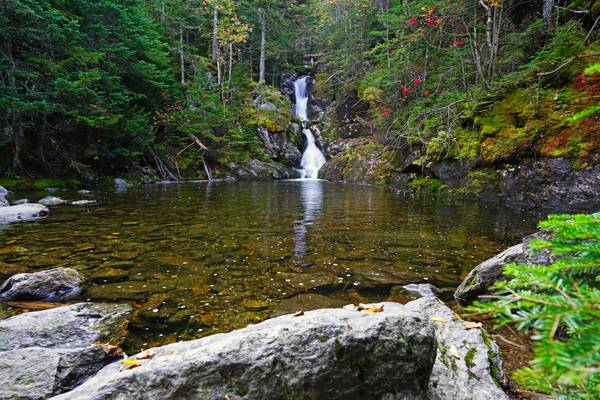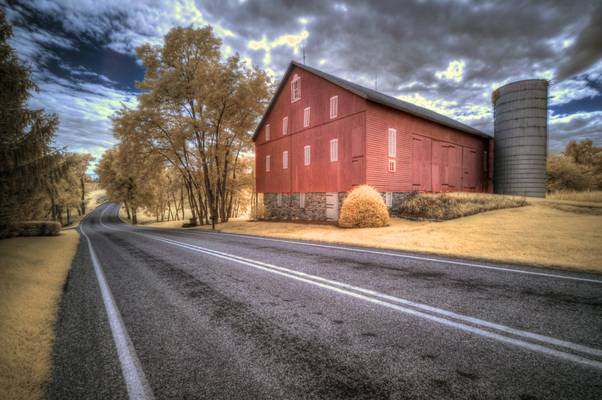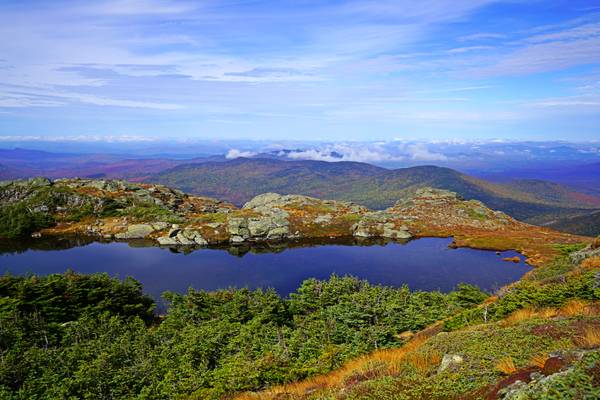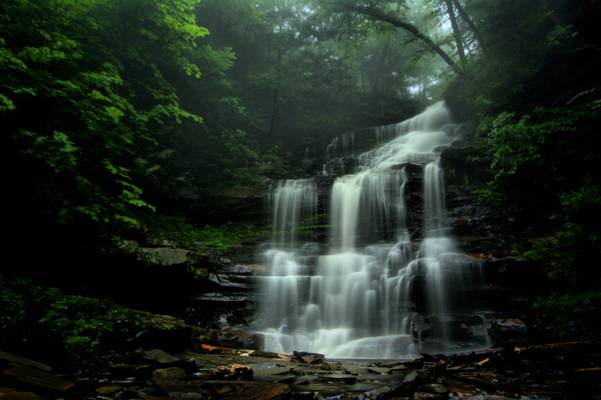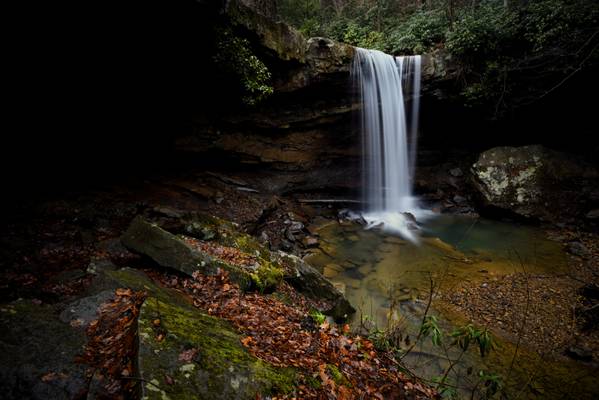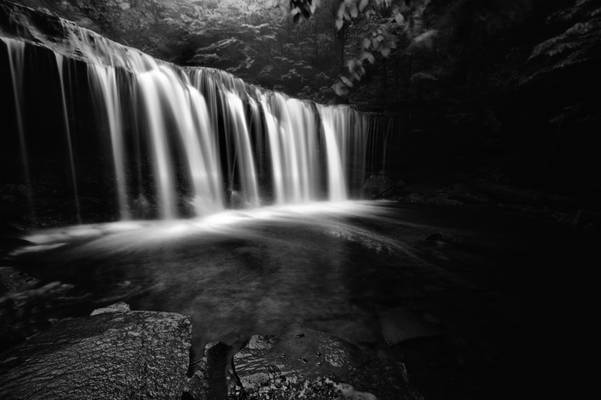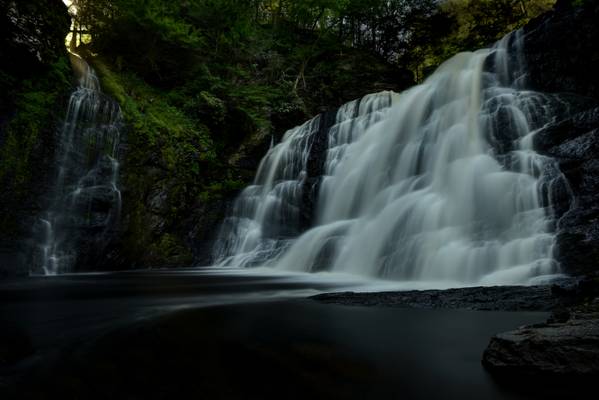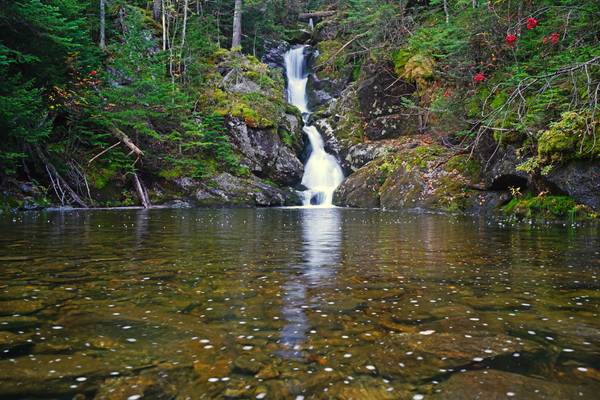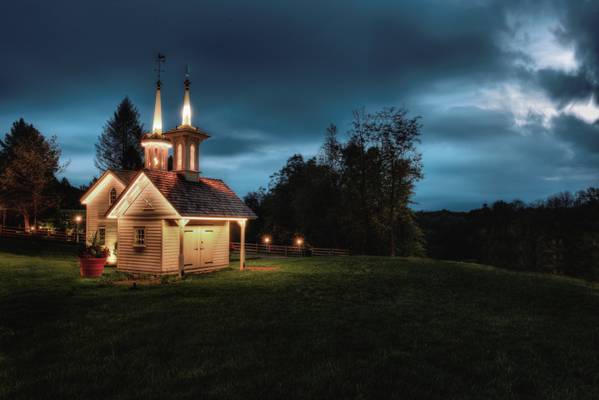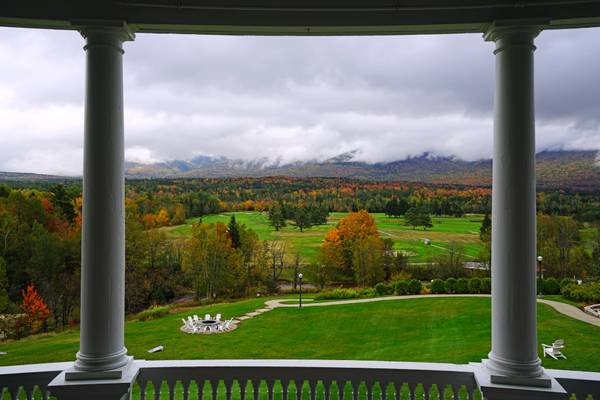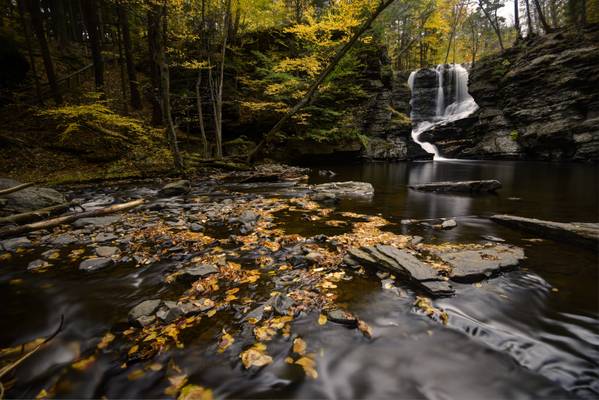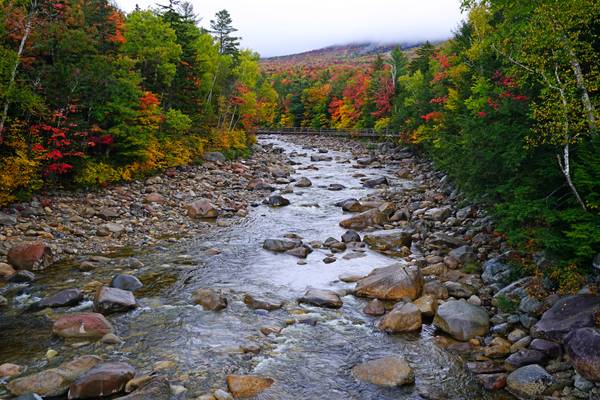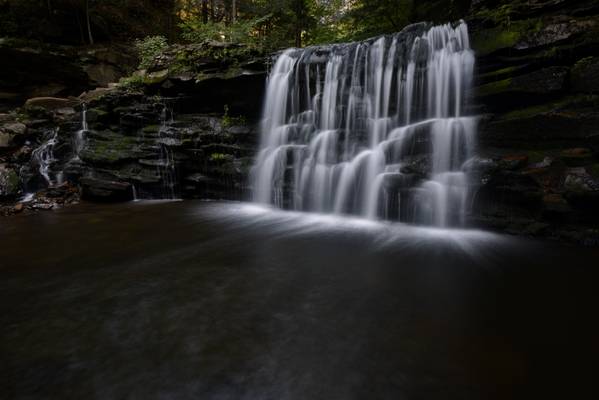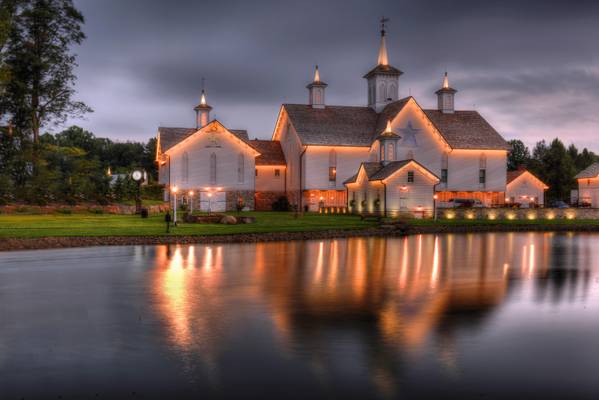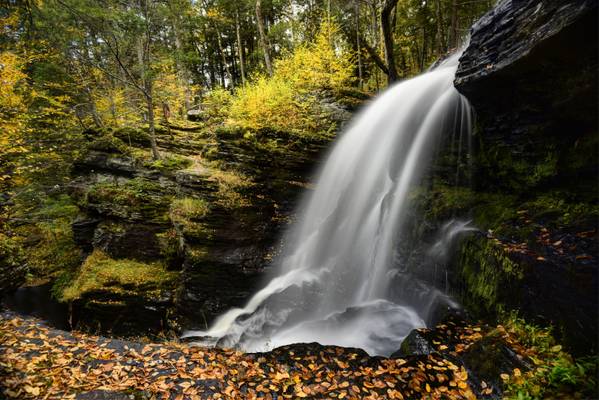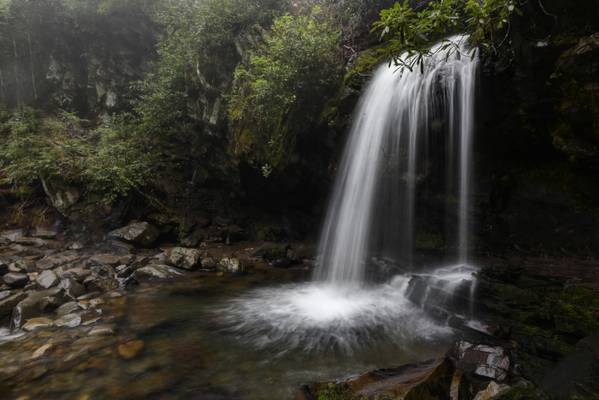
Appalachian Mountains

by Sandeep Thomas
- Jack Welch.
| facebook | 500px | ferpectshots |
In yesterday's post, I talked a bit about changing my approach to photography. The main reason why I embarked on this general change in thought process is partially due to some of the photo trips that I took while on the north coast. I used to take a lot of shots and used to come up with very few keepers, this approach continued after the move to the west coast as well, but gradually, I started to bring some of the practices that great photographers often employ to great success.
The first step was a change in approach towards my photo trips. I started to look at them as a first trip on many as opposed to thinking that this is my only chance to visit. The second step was to familiarize the area before taking out the camera itself. Many great photographers followed the practice, and it helped me immensely in getting over the FOMO. We started to spend more time exploring, hiking and generally enjoying the spots before waiting for the right conditions for taking photos. My wife helped with this immeasurably by acquiring a phone gimbal and by taking out short videos of our trips. It has helped me a lot in making meaningful images rather than spraying and praying for good shots.
This shot is taken on a road trip to Vermont, shortly before I moved to the west coast. The Moss Glen Falls is a popular roadside attraction and draws a lot of leaf peepers. I had to wait a good amount of time to get the fall all to myself. This type of event would have frustrated me a lot in the past, but I had allocated enough time into the plan, and this allowed me to relax and plan the shots that I wanted.
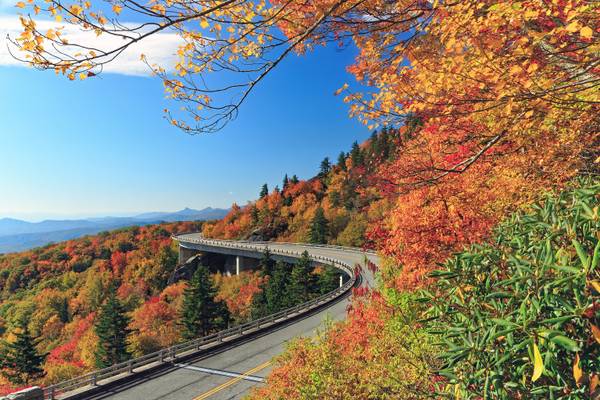
by Michael Kight
Perhaps you saw my image here www.flickr.com/photos/snapdraggin/30494945821/in/datepost... of Grandfather Mountain. It points out many things, not least of which is the Linn Cove Viaduct… it’s one of the most famous stretches of road anywhere, which is quite a feat, as it is found along another famous road, the Blue Ridge Parkway. Until the viaduct was completed in 1987, the Blue Ridge Parkway was effectively unfinished. Hugh Morton, who owned the mountain at that time, would not allow cutting into the side of the mountain to complete the road… you had a rather long detour to reconnect going either north or south along the parkway. The Linn Cove Viaduct was the answer to that problem, as it was minimally invasive to the mountain causing no damage whatsoever to the ecosystem of the mountain wilderness. The complex span of nearly a quarter-mile across involves two turns of tight radius, so tight in fact, that it took a powerful computer and 1,500 pages of specifications to get it right. At his death, Hugh Morton willed the mountain to North Carolina. It is now a state park.
This was taken from the ideal spot for the most iconic view of the viaduct, a rise of rocks on the north end of the viaduct. It’s a steep, though short climb to a precarious perch on those rocks, but it’s well worth the effort. I’ve worked my way up there for years (even at night, as seen here: www.flickr.com/photos/snapdraggin/21874790584/in/datepost...), but for one reason or another, I never quite got the shot I was after… until now. I’m so happy about that, as I don’t have to climb up there anymore… yeah, right.
Grandfather Mountain is quite a rise over its surroundings, as you can see here. Much of what you see in the distance, is the escarpment that surges up to the highlands. The two sharp rises that can be seen above the end of the viaduct here are quite iconic, too… Table Rock is on the left, and Hawksbill Mountain is to the right. Just the other side of them is Linville Gorge. There’s a lot to be explored here… but you still might find me sitting on these very rocks next year. There must be a way to top this shot, after all.

by Michael Kight
A thunderstorm over Price Lake with some autumn color was hard to pass up. When I got there, however, the setting Sun seemed to have taken the energy out of the storm. It began to shred apart above this high mountain lake (3,500 feet). Sunlight seemed to poke holes in the cloud, adding a sense of drama to the sky. As I’ve said in a previous post, I don’t as a rule shoot straight into a bright Sun, but this was hard to pass up. The storm receded enough to uncover the Sun, exposing the brilliance of the colorful fall foliage… the lens flare saturates it even more.
This was taken during sequestration by President Obama concerning a budget battle with the legislative branch of government. He had shut down the national parks as a result… you could still get to the Blue Ridge Parkway, but no services or campgrounds were available. I had the tripod set on likely the best vantage facing west. Before long, another photographer came to check it out. Though he spoke English well enough, it was tinged with a Russian accent. The sequester had occurred the previous day… he had been camping in his van and had planned to spend his evening here at the nearby campground, only to find it gated. Joyce and I had rented a cabin with a lot of room, so we invited him to spend the night… he was a bit reluctant at first, though he gave in.
His wife was a tenured professor at the University of West Virginia. When their schedules didn’t quite jive, he would take a driving sabbatical with just he and his camera. He knew some about the parkway, though little about its periphery. I was delighted to have him tag along to some highlights of the Blue Ridge in this area for the next few days. We made fast friends at the cabin’s table at breakfast and dinner… we were the same age… and we had once been determined enemies of the Cold War, he in the Russian Army, me in the U. S. Air Force. We traded many stories, some of his of which I had known the conclusions. While the meaning of Pravda was "truth", it defied the very definition of truth, and there was very little of truth in it as journalism to the people of Russia. Perhaps that's what our media has become, overall. Despite problems in this nation, one of the things that had stood out to him in his time in this country was the graciousness of the American people as a whole. He expressed that to me as he left to continue his excursion of the parkway… I asked him to just pass it along.
I’ve stood in this very spot to shoot stars on the darkest nights… bright images like this make me realize that the reason for light is to expose what lays in the darkness. My once upon a time “enemy” Russian friend reminds me of that. There's a lesson in there somewhere... figure it out.
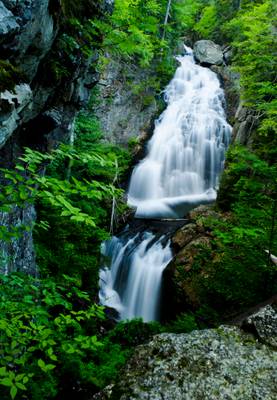
by Sandeep Thomas
- Mother Teresa.
Please view this on black.
Crystal cascade is rated as one of the best waterfalls in NH and I wanted to visit the falls before I left for New York. Most of the directions posted online for the falls state that its located just a short walk from the Appalachian Mountain Club Pinkham Notch Visitor Center on the way to White mountain auto road. So naturally, on my way back from there I went to the falls.
The nice lady behind the information counter told me that it's just a short distance from the parking lot, the distance was indeed short but was a little steep. I was really tired from a whole day of driving especially the nerve-racking Mt Washington drive and was in no condition for a climb. It took me almost 40 minutes to cover what other people were covering in 10 minutes but the waterfall was worth the effort, there is a nice viewpoint but getting to the base of the fall requires some skills and is impossible with a DSLR and a hefty tripod.
The Glen Ellis Falls is quite close to this one and is equally majestic. you will have to stop at the parking lot and take a tunnel to cross the highway and there is a beautiful pathway that will help you make it to the bottom of the falls.
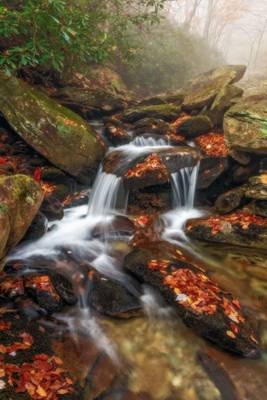
by Michael Kight
I’m not really chomping at the bit for autumn already… or am I? Fall, when conditions are just right, turns these mountains into something quite magical… especially when you can get a little fog action here at Boone Fork Creek. Being somewhere between 4,000-5,000 feet in elevation, the “fog” here is more aptly clouds after a storm swept through.
I’ve been going through many older images… and wondering why I’ve never posted some of them. Boone Fork is always a favorite place, especially when fog is present… to me, it adds a layer of beauty to the image and makes one wonder what’s seemingly out of reach. Though it can be accessed from many points of the Tanawha Trail, the best access point here is the Boone Fork Parking Area at Milepost 299.9 along the Blue Ridge Parkway… and the only way to truly hike the creek is by getting your feet wet.
The creek is situated between two steep rises in the Grandfather Mountain Highlands… the best way to hike it is by getting your feet wet. The creek bed consists of huge rocks that have tumbled from those rises throughout the millennia. The creek, which originates from the top of Grandfather Mountain, finds a path of least resistance through those rocks, often by little drops such as this one. With some of the purest and clearest water anywhere in these mountains, the air here is also is quite clean, particularly after the passage of thunderstorms. Though often I’m busy with the camera, I take the time to just soak in the natural beauty here… it is a place of reverie!
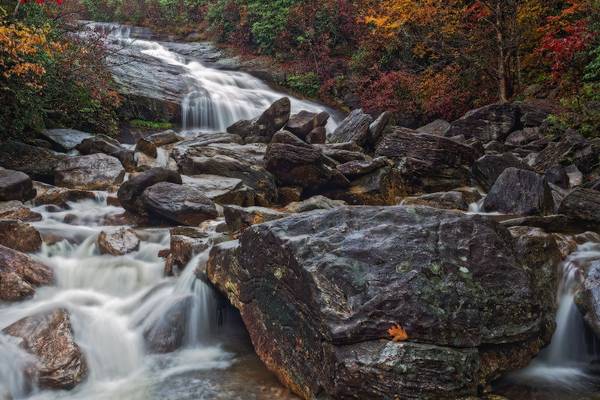
by Michael Kight
This was taken the day of my encounter with the camera club… that’s explained in detail on my image “Sunrise Over Courthouse Valley” several posts back. The gist of it is that they were in deep discussion as to their course of action because it was overcast, ruining their chances of a decent sunrise. My frame of mind is lemons to lemonade. I, too, headed for the high regions of the Blue Ridge Parkway with the realization it might not work for sunrise… nearby Second Falls worked out perfectly, however.
Here, the autumn foliage around the falls is as brilliant as it can be… who needs a sunrise? I shot this a short distance downstream from the falls where the jumble of boulders dominate the bottom of the image. As does electrical current, water current follows the path of the least resistance. There is no placid pool here… rather, the resistance these rocks offer sets up a myriad of smaller waterfalls along this drop.
One thing that stands out to me in this is the large boulder in the foreground. The full print size for this image is 24”x36” at 300 DPI… you can see incredible detail in that rock of not just the variation in color, but also of the moss and lichen evident on it. That rock is in a constantly wet environment, so there’s a lot living on it. The single red oak leaf (no, I didn’t put it there!) is also quite detailed and adds a sense of scale. It’s nice to go out with a thing in mind for the camera, and nature just works for you… I hope the “camera club” fared as well.
For those who do not know, Second Falls can be seen from the parkway at Milepost 418.5. Just south of there is the Graveyard Fields Overlook... you can hike down to the falls from there.
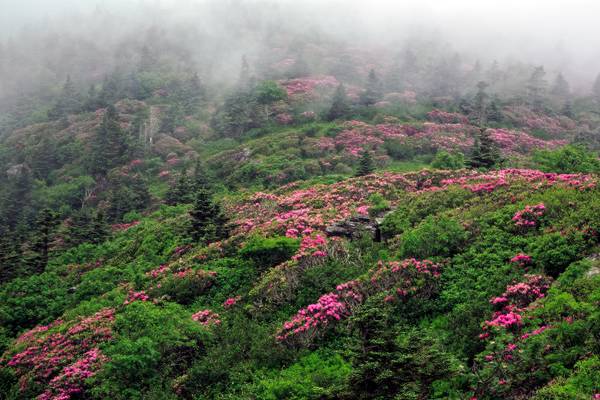
by Michael Kight
As I stated in the previous image, the Blue Ridge is covered in rhododendron… I wasn’t kidding! These are the showy magenta/pink Catawba that bloom from late May to early June, depending on the altitude of where they are located. Here along Grassy Ridge, they’re at nearly 6,000 feet (1,828.8 meters). That’s not fog up the ridge but rather clouds skirting the heights. It adds a sense of mystery to me, even though I'm very familiar with this place. The trail to this point leads through tunnels of interwoven branches of rhododendron, and it’s tight in a few places, especially if you’re carrying gear. The early colonial pioneers who first navigated these mountains referred to such thickets as “rhododendron hells” as it was easy to get lost among them. I wouldn’t suggest such a hike… but it’s amazing to see from above. Between the rhododendron are fir, mountain ash, and wild hydrangea for the most part. A note here to my UK-Irish friends... mountain ash here are what you refer to as Rowan trees. I've seen them growing at sea-level as I drove through Northern Ireland. Most of North Carolina's climate is of the humid subtropical variety, with the high Appalachians being the exception. We can use mountain ash as an altimeter here, as they're only found in elevations above 5,000 feet. The highest mountain east of the Mississippi River is Mount Mitchell at 6,680 feet here in North Carolina... which means the mountain ash will only be found on the highest ridges here, such as the one in this image.

by Sandeep Thomas
The wishing well at Luray Caverns. It takes quite some time for one to realize that the entire floor of the small pond is made up of coins......Also the way the lit up the place with strategically placed liggtings give the water a green hue which seems apt considering the amount of green it generated for the cavens (around $750K)..... I dont knif wishing ponds work as good as wishing wells, I think they got to be considering the amount of money this pond is making....
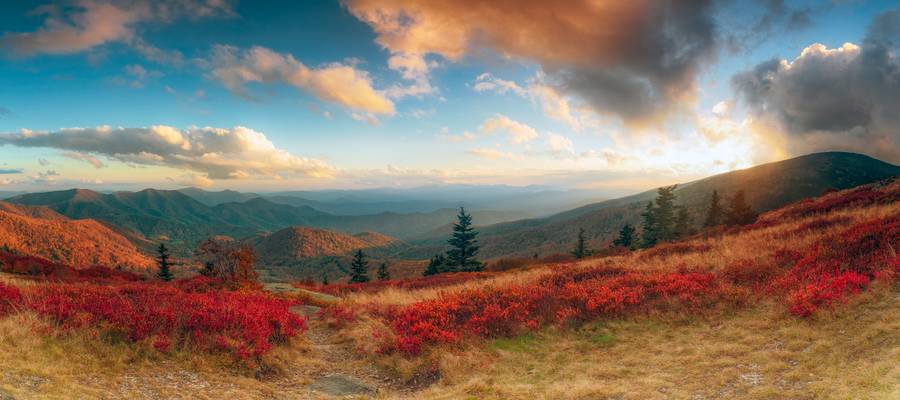
by Michael Kight
This is a repost. Likely thanks to the Flickr app's not-so-well placed delete button, it was apparently "butt-dialed" out of existence... I need to speak to the powers that be about that.
This is Round Bald, of the Roan Highlands, from a couple of years back. This is always a favorite destination in spring with Gray's lily, Catawba rhododendron, and flame azalea lighting up the bald, but what does autumn offer? I've had other photographers to tell me "Not much." Apparently, blueberries on fire framing the surrounding mountains dressed in autumn's finest isn't worth their effort. I beg to differ, but you be the judge.
I generally spend a week in the Grandfather Mountain region in the fall. That gives access to many places that shine in that season, like Rough Ridge, Linville Gorge, and Boone Fork, of which most favor morning light. Round Bald, especially with consideration of the mountain layers beyond it, favors evening light, so it's always a part of my photography agenda.
I approach photography with a sense of wonder. Even familiar subjects like Round Bald are always fascinating with the changing seasons and light. For all that, I still have room to learn. My wife and I work closely with many foreign students at Duke University through International Students, Inc. On a recent trip to the bald, married friends from China made observations that were not lost on me.
Both Jesse and Sophia (their Anglicized names) were transfixed with the clouds rolling across the bald. Jesse made two observations, the first being that it reminded him of Chinese mythology of immortals breathing mist. Mythology stemmed from people trying to make sense of their surroundings in a time before science. Both of my friends are Christians and well-versed in science, but for them, the highlands were otherworldly... even in my familiarity with the place, I could well understand their fascination.
While shooting his own photos of the mountains disappearing into the mist, Jesse just lowered the camera and looked around as he stated that he had "never heard such quiet." Earlier in the day at a mountain stream, Sophia noted that she felt as though her nose had just taken a shower. I love that description! The conditions of Beijing made our mountains stand out to these sweet visitors, and though I've not (yet) been to Beijing, they made them stand out to me, too.
We have friends coming from England in September. I drove 700 miles through England last year during a bank holiday. That made me realize something: England comprises roughly 4/5s of the total area of North Carolina, yet with a population of 50+ million people, England has 10-times the population of North Carolina... and I believe they were all on the road while I was there last year. We're picking our friends up in Charlotte and staying together in a wonderful cabin near Newland. I can't wait for their impressions up here at Roan Highlands... the blueberries should just be turning.

by Michael Kight
A few posts back shows this same location, though shot into the brilliant light of the rising Sun. This is looking the other direction just before the Sun popped up on the horizon at my back. This is more of a 23rd Psalm image than those brilliant shots, pastoral and peaceful. The hike down from here at Hawksbill Mountain is always one of contemplation of the beauty of God’s creation… always worth the hike up!
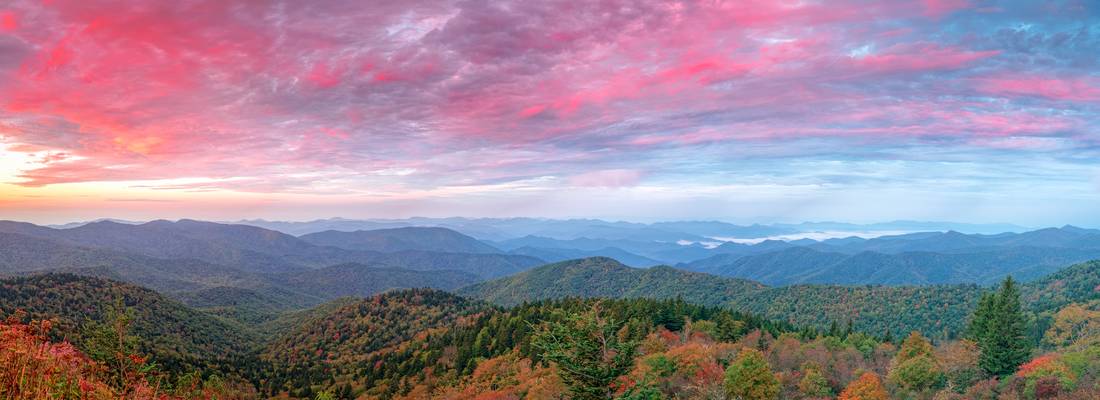
by Michael Kight
"The pursuit of truth and beauty is a sphere of activity in which we are permitted to remain children all our lives." Albert Einstein
I’m with Albert on this issue… have you ever truly watched young children at play? Theirs is a world of wonder, where they make up one adventure after another. Much to the dismay of many a parent, they must “grow up”, and often, a line is drawn between wonder and reality… and that’s a shame.
Are you familiar with the notion of NOMA? That’s an acronym for Non-Overlapping MAgisteria, a notion brought to us by well-meaning scientists who tend to be very narrow in their scope… in other words, God-less. In simplest terms, what it states is that in conditions where science and theology intersect, you must always side with science. Really? Who makes that decision? Empirical Science came about because of the Queen of the Sciences, Theology. The reason for science is to take us down a path toward truth, yet that’s the same reason for theology. It seems to me that at some point, science and theology won’t merely intersect, but merge.
I suspect that line between wonder and reality works much the same way, merging into a pursuit of beauty. Songwriters, novelists, and poets can be obsessive in their quest of just the right word. For painters, sculptors, and craftsmen, it’s the next notch or stroke that stands apart. For the photographer, it’s the understanding of lens and light, and being there, wherever “there” is… all in striving for a quality of perfection in the pursuit of beauty.
You notice this quality precisely because it is so rare. What generally brings a work of art alive is not its inevitability so much as the decisions that the artist made. We gasp not because the words, the impressions, or the brushstrokes are “right”, but because of what they reveal. They show us not a deterministic process but a sensitive mind making surprising and delightful choices. This is evident even in science, as pure mathematicians often say that it is precisely this quality that delights them in a great proof: not that it is correct but that it shows a personal, tangible human genius taking steps in a direction we’d never have guessed. That’s a direction showing that pursuit of beauty goes way beyond mere art.
Paul states in Philippians 4:8, “Finally, brothers and sisters, whatever is true, whatever is noble, whatever is right, whatever is pure, whatever is lovely, whatever is admirable—if anything is excellent or praiseworthy—think about such things.” This is one verse that is taken out of context more often than not. I doubt that it was intended as a set of lofty ideals to separate Christians from the secular. When you look at it in the reverse of separateness, could it be that it is a way for us to sanctify this culture through our faith? The secular culture of late seems bent on doing everything to put the “post” in the post-Christian Era… oh, there is the occasional intersect of the culture and Christian ethic, yet seldom without a true merge. An atheist humanist contact once sent me a video of an atheist humanist community out to prove that you don't have to be a Christian to do good. The spokesperson went on and on about that, but fizzled at the end when he tried to define 'good'... without a transcendent source to determine 'good', anyone can define it however they choose. Where culture and the Church diverge, it’s culture that must change, not the Church… but how is that done?
There is not one square inch of the entirety of creation about which Jesus Christ does not cry out, “This is mine! This belongs to me!” That quote is attributed to Abraham Kuyper, and he’s right because God owns it all, including the secular society whether they know it or not. That being the case, whatever is true, whatever is noble, whatever is right, whatever is pure, whatever is lovely, whatever is admirable can be found in the secular as well as the sacred. Can we find truth and beauty in people caring for each other in times of crisis? Do we see nobility in the sacrifice of a soldier, policeman, or fireman? Can it be right to enjoy a secular movie or song? Is it lovely to find a married couple that stays together when others are splitting up? Can we find something admirable about the sheer ability of an athlete? Could we not look for something praiseworthy in the ordinary talents and capabilities of everybody we meet? Do you think the secular world would see something excellent in us if we could point to what is excellent about it? Is there a possibility that the ugly ideas of this world would get pushed back into the shadows if we brought out the beauty of God’s truth in it? Is there anything of value in the secular world? The constant pursuit of beauty might reveal it… but grateful people who see the beauty in grace already know that.
The things that we find beautiful today we suspect would be beautiful for all eternity. This is where God’s Word breaks in: “The heavens declare the glory of God and the firmament shows His handiwork.” Psalm 19:1… even God, as an artist, is expectant of beauty.
This was taken from the Cowee Mountains overlook near milepost 430 along the Blue Ridge Parkway here in North Carolina. Cowee (pronounced Co-wee) is a derivative of a Cherokee word meaning 'place of the honey locust', a tree they used for food. It is by far the best place for sunset on the BRP, but as you can see, sunrise can be spectacular, too. After many mornings of standing here in the cold and darkness trying to ply my handiwork as a photographer at this spot, the long red wavelength of light found its way from across the horizon and saturated the low clouds to compete with autumn over the cascading mountains. I stitched 7 vertical images to catch that big sky, yielding an image 66”x24”. I understand the science behind this image, but to be honest, in the wonder of this morning, I knew God threw me a bone... much appreciated! “f/8 and being there.”
To Be Grateful
For life, for breath For daily strength and bread. O, let me not forget - to be grateful For moon and stars, When the road is dark, Lord, for your holy scars – to be grateful That you call me friend For the grace to stand And the mercy that I need By your sacrifice Jesus, I’m alive So what tribute can I bring Here is my heart offering – to be grateful, endlessly Here is my heart offering – to be grateful In highs and lows Whether joy comes or goes Lord, let it shape my soul – to be grateful For friends so rare, When it rains despair, And even near death to dare - to be grateful CHORUS For life, for breath For daily strength and bread. O, let me not forget - to be grateful
@ 2013 Skin Horse, Inc (ASCAP) by Billy Sprague

by Michael Kight
I’m getting prepared to get out to the mountains soon for some winter photography… some in my circle here in Durham don’t much understand that. This image is from the fall of 2015 at Boone Fork Creek. I was pretty upbeat this day, though there were some who questioned my sanity on getting out to photograph in the clouds that had dropped over the highlands. As you can see, it was a perfect day to translate nature’s beauty through photography. No, it’s not the sunshiny day many would go for… but they’re missing out. My photographer buddies in the mountains know better and can find beauty where you least expect it.
That same understanding comes to the forefront this time of year, though with regard to everything in our lives, not just photography. It seems many choose not to look for beauty in this world for one reason or another, especially with concern to a post-Christian culture. Ecclesiastes 3:11 points out something pretty extraordinary, however, with that as a concern: "He has made everything beautiful in its time. He has also set eternity in the human heart; yet no one can fathom what God has done from beginning to end." Perhaps it's time to tap into that "eternity" to see this world the way God does... chances are you will find beauty where you least expect it. Go be beautiful!

by Michael Kight
This moment was one like many in my life behind the lens. I’m torn between camera settings, composition, and environmental factors… and just sitting there to try and breathe it all in. After a brief pause, I realize it’s just as well to get back to the business of translating this scene into an image… otherwise, I might try to comprehend such magnificence, and that would be no less than an exercise in futility. Besides, there are steep rocky cliffs here, so it’s best to keep your head out of the clouds. Even that may not be possible here, however.
Minutes before this scene opened to this glory, my head was in the clouds… literally! I arrived here late in the evening. I had attempted to get here much earlier but one thing or another kept me grounded in Durham. About the time I could square every hindrance away, Joyce was getting off work at the hospital… we decided to go for a quick dinner before I left, effectively assuring an even later start, though joyfully so with her. We ate at a place just off the interstate which gave me a quick launch toward the Blue Ridge Mountains after we parted. It was dark by this time, which gave me a good indicator what I was heading into… the unmistakable shape of a thunderhead was in my path. Rising high over the horizon, it was lit from within like a light bulb against the night sky by its furious energy.
Ten miles further west had me well into the throes of that storm. It was like driving in a flood, but I knew this road and I knew my car… it wouldn’t slow me down much! Or so I thought. Ten miles more up the road, the driver’s side windshield wiper decided to eject… for crying out loud! “What else can happen?” I regretted those words the instant I said them… the day had proven that anything else could happen. Fortunately, there was a 24-hour Walmart nearby that had the right blades. I changed them both, in the rain, and had no more incidents for the next three hours. I rolled into the parking area for Hawksbill Mountain in the Linville Gorge Wilderness past midnight… I set the seat back, snugged my jacket up, and snoozed for a few hours.
Waking at 4 AM was a bit disorienting… even in the darkest nights, I'm able to see something outside, but I couldn’t see anything out the windows! That’s because a cloud had parked itself right over Hawksbill. My friend, Paul McKenna, taught me a song many years ago when we were involved in camp ministry, that he had learned while a student at Virginia Tech… “We’re Here Because We’re Here”... That's the entire lyrics, sung to the tune of Auld Lang Syne... give it a try and see if you can get it out of your head. That was my song on the somewhat discouraging dark and foggy hike up to the crest of Hawksbill... there are bears, bobcats and coyote up here, and I was alert for bumping into something that might try to eat me... no worries, though, as my singing likely kept them at bay. It was still socked in when I reached the top… as it began to lighten up with the coming morning, I investigated what compositions might work out best given the conditions. There are some of you who know that you just don’t flit around that location… Hawksbill is steep in many places at the top, and I’ve seen more than a few people ‘crash and burn’ up there on the slippery rocks… I’ve never laughed out loud at those antics, but I’ve wanted to because I had warned many of them about the conditions… “Told you so!”
I tend to my footing up there, especially because I’m carrying heavy gear… but on this day, as I moved from one side of the “bill” to the other, I slipped on the steep rock! Instead of falling, however, I quickly adjusted my balance, planted both feet, and only slid until I found grip again on the rocks… after all I’d been through the previous day, I was happy for an incident averted! As I made my way to the place in this image, wind from the warming morning pushed the cloud off the mountain… and in nearly the same moment, a veil opened to the east revealing a shimmering curtain of sunshine! I quickly set up the camera, set the ISO up a bit to account for the wind (the landscape photographer’s lament), and prayed for the wind to stop… and it did… so come on morning!
There’s a lesson here… no matter your situation, motivation isn’t what should drive you. “We’re Here Because We’re Here” is motivation enough to put one foot in front of the other, but it’s discipline that drives you to stay at it until you get what you’re after. It’s all about discipline… you keep going regardless of conditions. You push through even when it seems everything is against you. And it doesn’t always pay off… but when it does, it can be remarkable. Sometimes it’s a rough and rocky road that takes you to a beautiful place… “Come on morning” is my rallying cry to stay on point, even in the worst of moments.
This image is a progression of my recent posts of the rhododendron of the Blue Ridge. This is the Carolina rhododendron that, while rare in this world, is found in abundance here at Linville Gorge. It blooms earlier than the other rhododendron… and unlike the Catawba and rosebay rhododendron, it is a true pink, though even that may be a misnomer. Scientists seem to believe pink is not a true color… pink would be a combination of red light and violet light, tempered by white light. The problem is that red and violet are at opposite ends of the color spectrum (remember ROYGBIV) and do not converge in any way whatsoever! Well, that is unless you’ve seen rainbows bent like pretzels. Apparently, the light reflected off pink objects is somehow twisted in our minds to reveal pink. So, if you see pink here, then you and I are either delusional or we’re prone to wishful thinking… either way, we can still be just as happy. See? Two lessons in one post… you got your money’s worth!

by Michael Kight
I’ve had some trouble with my eyes over the last month with a condition known as Posterior Vitreous Detachment (PVD). It happened with my right eye when I was washing my eyes out while taking a shower. There was an explosion of sudden sharp floaters and flashes of light, and it was evident my sight in that eye immediately degraded… I liken it to peering through dirty glasses with a bit of glare to boot. I made an appointment with my optometrist two days later. I was relieved to find out that this is something that happens to folks as they age, usually ranging from ages 50-80… after age 80, it’s pretty much expected. A week later, I was reading an article about PVD that stated if it occurs in one eye, you can expect it in the other eye within a year. I told myself, “Alright! More good news. Bring it on!” And 3-hours later, it did.
While relieved that I wasn’t going blind, I was resigned to the fact that I am at that stage in life… I’ll be 64 at the end of December. That said, I didn’t let it keep me down long… my personality is more Tigger than Eeyore, so I continue bouncing toward what makes me better function as the person I am as opposed to dwelling on things I can’t change.
One of the things I look forward to is putting my camera in front of interesting places. While color in the mountains didn’t work out too well for the upper elevations, the lower elevations worked out well with autumn showing itself well beyond what it normally does. I took advantage of that this past Sunday and Monday on a waterfall excursion around the western end of North Carolina Highway 64… I walked off with some images I’m happy with that I’m still sorting through. This one of Crabtree Falls, however, is from 2015… and there’s a reason I’m posting it first.
I had to go back for a visit yesterday for my one-month check since the diagnosis with my eyes to make certain there were no further problems, such as tears in the iris or back at the optic nerve. All is good with that. While I was there, the assistant prepping me for the optometrist had mentioned that she, too, had just come back from the mountains and had hiked a waterfall near Ashville that was quite strenuous for her. I asked what waterfall… it was Crabtree Falls off the Blue Ridge Parkway near to Burnsville. It’s not a long hike, about a mile down, but “down” is the key word there… it’s steep, though so worth the effort if you find conditions like this.
Waterfalls can be described as anything from cascades to plunge falls… this one finds itself in a different category, as Crabtree Creek winds itself down to the chute above the falls, then spreads across the 70+ foot near vertical rock face into what appears as a delicate lace veil.
My vision has improved over the last month. One particularly well-defined “floater” is known as Weise’s Ring, material left over as the vitreous loosens from around the optic nerve… it was so well-defined that for the first few days, it made me think that something was flying around me that warranted swatting! There are also clouds of other material that appear as swarms of tiny zeros with a dot in the middle of them… go figure! This material is likely causing the glare I see. Things are settling down now. The brain actually cancels out the sharpness of the floaters to the point they are quite a lot less noticeable. The optometrist informs me the “zeroes” will likely go back to solution within the eyes in the coming year. The ebullient Tigger in me is confident that my sharp vision will return, assuming I make it through the year… even Tigger needs to see well enough not to bounce into the oncoming bus!
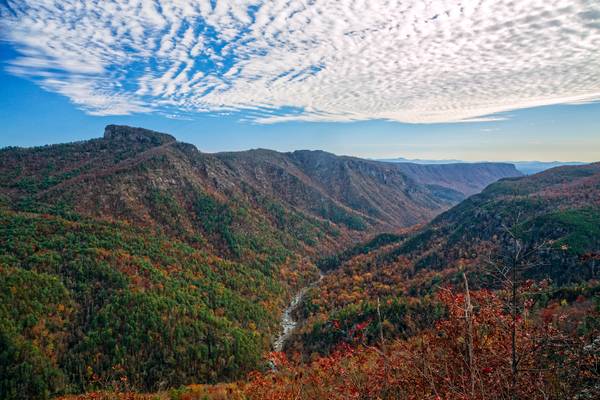
by Michael Kight
I’ve had a lifetime of things just out of reach of my heart… it’s right there within sight, yet it may as well be in another galaxy for what it’s worth. You can’t tell me honestly that you haven’t been there, too. I was in the grocery store yesterday and observed a toddler ensconced in a buggy (a shopping cart for those of you without a southern dialect) hollering her lungs out because her mom wouldn’t let her have what was just out of her reach… I think suppliers of those stores put such items at their eye level for just that reason. “Mom” merely pushed her out of range of the object, but the blubbering continued... she will be inconsolable and forlorn the rest of her life, or at least until the next thing comes along.
I remember a girl from high school who was the most gorgeous woman I had ever seen. I remember she was tall and shapely with long dishwater blond hair and eyes that were so brown they were like dark pools I wanted to drown in. Her family raised Charolais cattle and I just knew I was going to win her over and become a cattle baron. Only one problem… she was out of reach, as were so many other things to come.
As a landscape photographer, I’ve found that same principle is evident, too. I watched many of the best sunsets from the rearview mirror on drives back home from the mountains or the beach. I’ve missed major wildflower bloom peaks by only a matter of days. The weather hasn’t quite worked out. Traffic problems. Not prepared as well as I should have been. The list goes on.
I’ve shot here from Wiseman’s View for years, yet I’ve never quite gotten the shot I had in mind here… until now. This past weekend, I drove my wife and a friend to a church women’s retreat in Valle Crucis here in the North Carolina mountains... after dropping them off, I get lost in those mountains. I always look forward to that, even though it’s rather late in autumn… any excuse to poke around in the mountains for a day or two. Despite the fact many leaves have been evicted by the wind, there was still some interesting color from sunlight filtered through high cirrocumulus clouds. The detail of the ruggedness of this section of the gorge stands out in this image. Table Rock is prevalent here looking off into Shortoff Mountain. That's the Linville River, a quarter-mile below Wiseman's, winding through the gorge. Even from so far away, the roar of whitewater can easily be heard. I’ve finally got the shot I’ve been after for years, so there’s no need to go back… Ha! That’ll never happen as long as I’m able. The next shot may be perfectly different.
As a Christian, I’ve come to know purpose in life… and I believe things happen for a reason. Much as it was for that little girl in the grocery store, some things out of my reach were never intended for me. I recently saw a fairly up-to-date picture of the girl who broke my heart in high school… the passage of time has not been kind to her, perhaps for a number of reasons. That might be said for me, too, though the path of those things “just out of reach” have led me to wonderful friends, a delightful and brilliant wife I love to do things for, and a life I could never have imagined when I was that young fella in high school. Those things just out of reach make you work harder for the life you were meant for. It’s worth it all, so go get it!
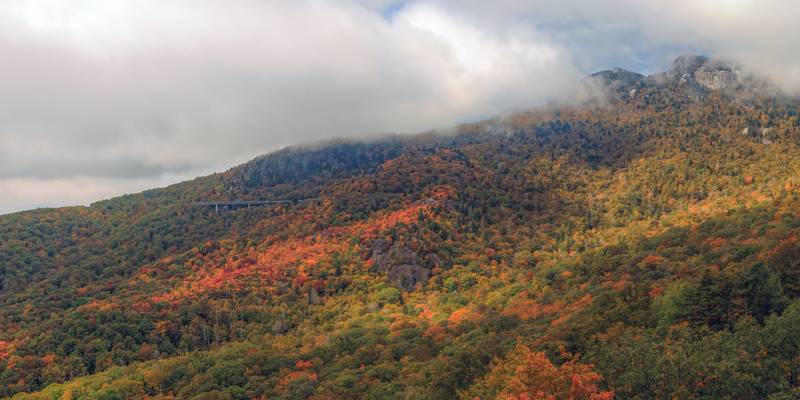
by Michael Kight
Whose head’s in the clouds? Grandfather’s is… literally! At over a mile up, the prominences of Grandfather Mountain often reach into the clouds. This mountain was named “Grandfather” by pioneers who imagined the face of an old man among its cliffs. The original Cherokee name for the mountain was “Tanawha,” meaning “a fabulous hawk or eagle.” The Tanawha Trail, which follows along the slopes of the mountain, and connects portions of the Mountains-To-Sea Trail, is marked by a feather. Here, Grandfather is all decked out in his finery… there are few places in this world that show autumn off as well.
This image also highlights one of the most famous stretches of road anywhere, the Linn Cove Viaduct. Until the viaduct was completed in 1987, the Blue Ridge Parkway was effectively unfinished. Hugh Morton, who owned the mountain at that time, would not allow cutting into the side of the mountain to complete the road… you had a rather long detour to reconnect going either north or south along the parkway. The Linn Cove Viaduct was the answer to that problem, as it was minimally invasive to the mountain causing no damage whatsoever to the ecosystem of the mountain wilderness. At his death, Hugh Morton willed the mountain to North Carolina. It is now a state park.
That colorful crest just below the viaduct is Yonahlossee Ridge. Starting at the topmost rock outcropping near the Blue Ridge Parkway and working its way down the ridge, this is the area of the first fall color to show up anywhere within this region… that’s why it’s so lit up now. The trees along there are mostly maples, though a close view reveals a stand of scarlet sourwood as well. I used to climb out over those rocks years ago, but they’re closed off now due to “endangered” plants. “Yonahlossee” is another Cherokee word meaning “trail of the black bear”… must have been something to that, as I saw one in that area this year.
No one is certain of an “official” profile of the mountain, as witnessed by those who first saw the prone image of an old bearded man among the crags of the mountain. However, the most popular profile can be seen from the community of Foscoe, seven miles north of Linville and 10 miles south of Boone on N.C. 105.
This is a composite image from 5 vertical images stitched in Photoshop ACR, yielding an output image of 72"x36". Sunlight, finding its way through the clouds, lights up the steep ridges, highlighting the ruggedness of Grandfather's wilderness.

by Michael Kight
In 1540, Spanish Conquistador Hernando de Soto and his men explored Cullasaja Gorge in their quest for gold. The cascades here stretch for about a fifth of a mile across densely forested rugged terrain before making a final drop into the gorge from Cullasaja Falls. It makes you realize that had to have been a particularly mean hike for the conquistadors… they would have had a better time of it had they marched up here at highway NC64 where I shot this from.
There’s a short pulloff on NC64 between Highlands and Franklin, North Carolina, where you get the best view of Cullasaja Falls, which, to me, is the most impressive waterfalls in the state when the water flow is good. It was raining this day, with even a wisp of cloud evident in the image… and you couldn’t ask for better light to make the autumn colors pop. This “spot”, however, is at the apex of a blind curve and very close to the edge of the road… I've watched people stand in the road for “selfies” here, oblivious to how fast a vehicle will suddenly appear at either end of the curve. You need to use your noodle here or you’ll wind up as noodles on the pavement!
For as beautiful as it is, the face of the waterfall has become occluded over years by a scraggly rising foreground. I didn’t include it in this image for that reason. I do understand that it is the least of our problems in this world but being that it draws so many visitors to this neck o’ the woods, it would be great to see the view cleaned up… maybe we should start a petition. Who knows? It just might happen.
If you didn't know, Cullasaja is a Cherokee word meaning honey locust place. The honey locust is a tree. The name derives from the sweet taste of the legume pulp, which was used for food by Native American people. The long pods, which eventually dry and ripen to a leathery skin that sticks to the pulp within. The pulp, which is bright green in unripe pods, is strongly sweet, crisp and succulent in ripe pods. Dark brown tannin-rich beans are found in slots within the pulp. It can also be fermented to make alcoholic beverages… the Cherokee were obviously an advanced civilization!
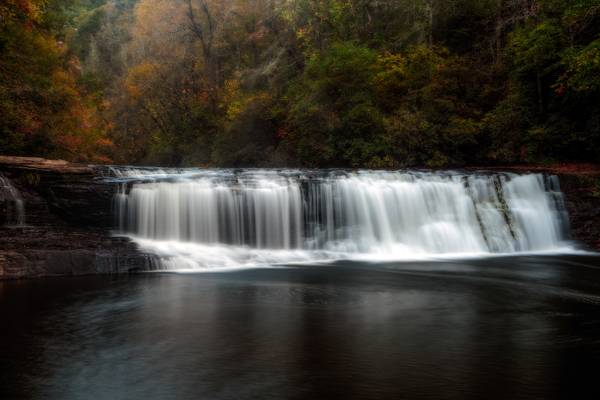
by Michael Kight
I’ve been quite busy with issues that keep me close to home of late. One of those things is the Alpha Marriage Course that my wife and I have helped produce at our church… we’re amid the fifth round of eight-weeks each that we do twice a year. The course is free to those who attend each Thursday. We provide great meals, child care, and a wonderful ambiance to go with the program… but that takes an incredible amount of teamwork and dedication to produce each week. I’ve determined to make it up to the mountains, however, to see them dressed in their October finest, so I’m working around that hectic schedule.
Thursdays during AMC find me on my feet most all day long until the last of cleanup around 9 o’clock later that evening… Friday’s are recovery days. I spent Friday making plans for a photography foray into the Blue Ridge Mountains of North Carolina… a problem beyond a commitment to the program occurred to make a mess of things this year: Hurricane Nate. Sunday and part of Monday were to be a washout in the mountains, so I decided to head to the high southerly portions of the Blue Ridge Parkway near Pisgah on Saturday for an eyes-on survey before committing to a couple of nights in the region. Nate, now downgraded to a tropical storm, had also degraded visibility there as the high mountains reached up into the outer bands… I did get a glimpse of color in some places, though the parkway was closed at Black Balsam Road in anticipation of high winds and rain creating havoc with rockslides and trees… better safe than sorry. Though it was approaching sunset, I worked my way down Highway 276 toward Pisgah Forrest and beyond to DuPont State Park for the possibility of a waterfall shot or two before returning home… I’m glad I did, as I walked off with something nice and I can concentrate on other places in the region this Monday evening through Wednesday. This was taken as it was darkening... but it was absolutely windless and the darkness allowed for a 20-second exposure, which flattened out the turbulent water for some great reflections.
Nate did do some damage in western North Carolina, with a confirmed tornado in Caldwell County. Tragically, a Morganton firefighter was killed instantly when he was struck by a car while clearing storm debris from Highway 70. Please remember his family in prayer. Apart from that, it appears the Blue Ridge Parkway has opened all but a few spots, mostly appearing to be a couple overlooks… I’ll know for sure later today.
Sunday was spent doing some prep work for Thursday’s meal… it’s baked ziti this week, with Caprese salad and tiramisu for dessert. It helps to get ahead of the game, although remnants of Nate should make for some great sky scenics along the high regions of the parkway and that calls to me. Thursday is slated to be a “bright and beautiful cloudless day”, which as you may know is anything but beautiful to the photographer, so I won’t be missing much on my return to duties in Durham.
I’m going to try for the Linville Gorge region next week… who’s going to be there?
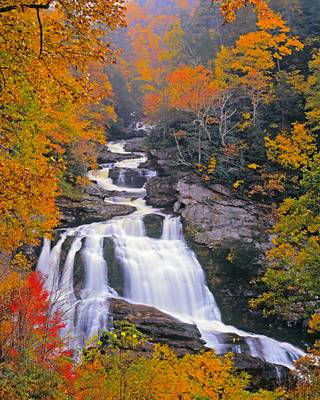
by Michael Kight
Seen roadside off NC64 between Highlands and Franklin, North Carolina, Cullasaja Falls is one of NCs most impressive waterfalls. It is the last major waterfall on the Cullasaja River as it drops into the rugged Cullasaja Gorge. In 1540, Spanish Conquistador Hernando de Soto and his men explored the gorge in their quest for gold. If you've ever seen this area, you'd realize that had to have been a particularly mean hike.
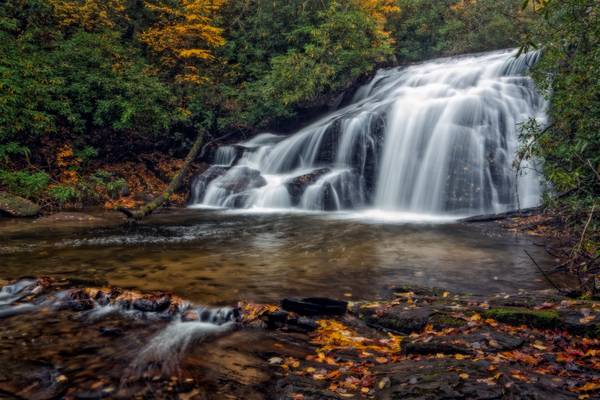
by Michael Kight
I hadn't been to White Owl Falls for many years before this autumn. That tree trunk left of the falls is the reason why. Fallen from a storm years ago, I found my way down here shortly afterward to find that intact tree occluding the face of the falls, hiding its beauty... but that's not what makes it hidden.
Heading south on North Carolina Highway 281 (Whitewater Road) toward South Carolina, there’s a pulloff on the right that fits perhaps a few cars just past Brewer Road. It’s a short hike from there though not exactly an easy one. The hike gets interesting just beyond the beginning of the guardrail across from the pulloff… there’s no definitive trail from that point. There is a concrete chute, however, that indicates you’re in the right place. Follow that chute down from the road, and be careful, as it can be slippery, and you don’t want to shoot out of the chute! Continue in the same direction paralleling the road, not further down. This seems to confuse a lot of folks, yet the faint trail becomes more evident as you move along it, as does the roar of the falls.
I wore my high Bogs boots on this hike, as I planned to work out every composition I could eke out of White Owl. Fortunately, Thompson River here isn’t quite like the Hudson River, other than the fact it’s wet and it’s a river… I can traipse around the falls in my Bogs without getting my feet wet. It was fascinating to me to be standing amid such beauty while hearing cars whizzing by overhead, with drivers and passengers oblivious to this scene.
The camera got a good workout there and I had other waterfalls to get to in my limited time there in the Blue Ridge. Yet, having packed the camera for the hike out, I just had to sit there and enjoy the reverie of this hidden beauty.
The State Funeral of President George H. W. Bush (41) just ended and the theme of “hidden beauty” throughout it struck me. There are problems here in America, but at times like this, it's evident decency is still the core value of Americans. I teared up along with President George W. Bush (43) as he eulogized his dad… the things he related to his dad spoke volumes about my dad as well, whose funeral I had eulogized a year and a half ago. That was one of the hardest things I have ever done, and I broke down as well… my heart went out immediately to 43 when he choked up, as that’s not weakness... it’s humanity at its best. The issues he stated of note: “He looked for the goodness in others, and he usually found it.” “He put character before pedigree." And, “Hatred corrodes the container it’s carried in.” Would it be too much to ask for Christmas that we all embody these things?
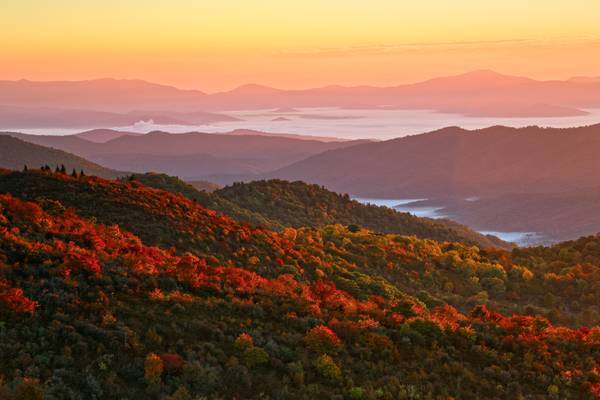
by Michael Kight
I don’t know about you, but “coming attractions” often generates more excitement than the actual event. While going over some images of past forays into the Blue Ridge, I came across some like this that I overlooked at the time. This process helps me to set my mind to the places I would love to set the camera in front of… again. This is from 2015. I spent a good two weeks putting in the footwork necessary to get ‘the shot’ but the morning weather rarely provided what I was hoping for… just open blue skies with no clouds to reflect the dramatic color phases of a rising sun. Sometimes, however…
Have you ever had folks to tell you that it’s just another sunrise? I have, and I believe they’re missing the miracle of it. I arrived at this spot while it was still quite dark, not too particularly thrilled with the evident coming “blue” day, but prepared to take it on nonetheless. Yet, there was just enough humidity in the air to make things interesting. One of the reasons for light is to expose what lays in the dark… I watched as the sky became brighter with the rising sun and the mountains and clouds like billowing seas covering the valleys began to take shape. The first golden touch of sunlight fired up the autumn palette of mountain ridges and muted the open horizon like a delicate watercolor painting. It added depth, contrast, and definition to turn these oh so familiar mountains into an ever-changing wonderland… and did so much to reset my attitude for that day and the days ahead.
The “coming attraction” for many in this region of the world is the promise of autumn here in these mountains to showcase what the light exposes… that palette is a marvel, but so is the brilliance that highlights it.
Ephesians 5:13, “But everything exposed by the light becomes visible – and everything that is illuminated becomes light.” That’s yet another coming attraction for an event that I guarantee will not let you down. The recent death of a dear friend whose memorial we attended Saturday brings this to the forefront... he loved these mountains as much as I do.
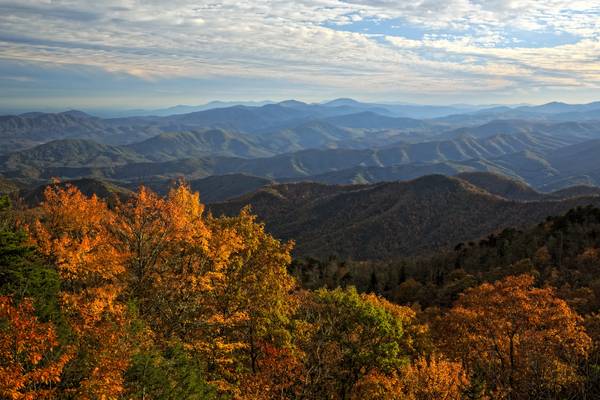
by Michael Kight
Roads? I don’t see any roads.
“Where we’re going, we don’t need roads!”
Perhaps not, Doc Brown, but we have to get there before we can hit the trail, so to speak… headed to the Pisgah area for a week, then off to Linville for another week. There’s got to be a good picture out there somewhere… if you’re in the area, give me shout and I’ll send you my number. Hope to see some of you along the way!
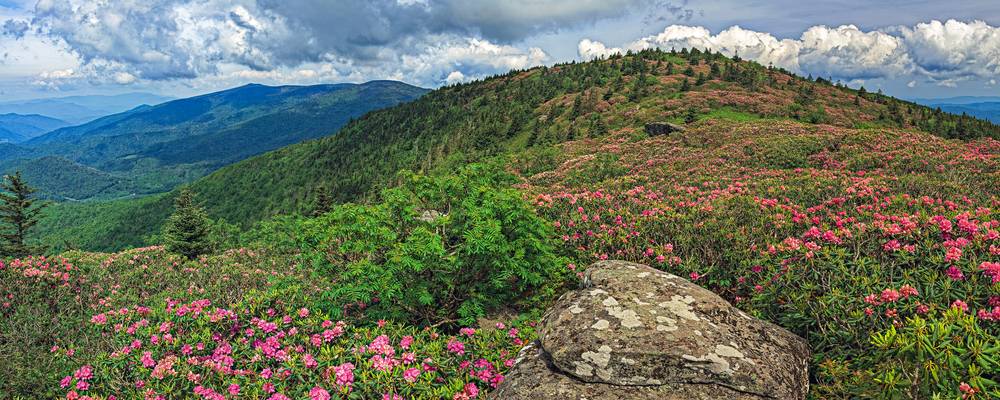
by Michael Kight
Having posted the cloudy version of Grassy Ridge two posts back (titled "Rhododendron Hells"), it occurred to me I had never posted this image from 5 years ago. The original is a composite image of 9 vertical shots that is 72”x24”, though with detail that could make it larger if necessary… I’ve pared it down using the same aspect ratio to 60”x20” that drops the printing costs of an exhibition metal float print somewhat exponentially.
Grassy Ridge Bald is the longest stretch of grassy bald in the Roan Highlands area of the Appalachian Mountains. You will never see this roadside… seeing it requires a hike starting from Carver’s Gap, located on State Route TN-143 and NC-261, which connects the towns of Roan Mountain, Tennessee, and Bakersville, North Carolina... you park on the state line! The Appalachian Trail winds its way through Roan Mountain State Park… it is along this trail that you begin to work your way up until it intersects a spur trail at the boundary of Grassy Ridge Bald nearly 2 miles from Carver’s Gap
Roan Mountain has five sub-peaks that comprise the Highlands and is divided into two sections by Carvers Gap. To the west of Carvers Gap are Roan High Bluff and Roan High Knob that are easily accessed by road as well as trail… the world-famous Roan Rhododendron Gardens that are handicap-accessible. That’s a wonderful option for those who have a hard time getting around… but it’s hard to beat the view from Grassy Ridge. East of Carvers Gap, accessible only by hiking, is the area of Roan Mountain known as Grassy Ridge, which includes three peaks: Round Bald, Jane Bald, and Grassy Ridge Bald. At an elevation of 6,189 feet (1886 meters), Grassy Ridge Bald is one of the highest grassy balds in the Appalachian Mountains.
There’s a lot to see on the trail to this point and you get many different perspectives along the way… the hike takes a little over 5 miles straight up and back, with a total elevation gain of 1,150 feet (350 meters). My hikes there are never less than 8 miles round trip and often more as I move around for those perspectives to put in front of the lens… but this place is the jewel at the end of the trail. To get this image required scrambling up the huge rock you see in the foreground to get above it all. While this would make a wonderful print, I've not caught the quintessential shot I've had in mind of this place just yet... it's been too windy, or too cloudy/foggy, or the light's just not right, or I'm too early or too late for peak conditions... or worse, any combination of these conditions. I guess I'm just going to have to keep making my way up there until I get it. I'm just kidding myself... even if I did get what I think I want, I still would never be satisfied. Would you?

by Michael Kight
This is the top tier of Whitewater Falls in the North Carolina Blue Ridge. If you get there at the right time, you can catch a nice rainbow in the mist below. The remnant of Hurricane Ida has been blowing through here the last few days dumping a horrendous amount of rain as it goes... this picture would look quite different today, no doubt.
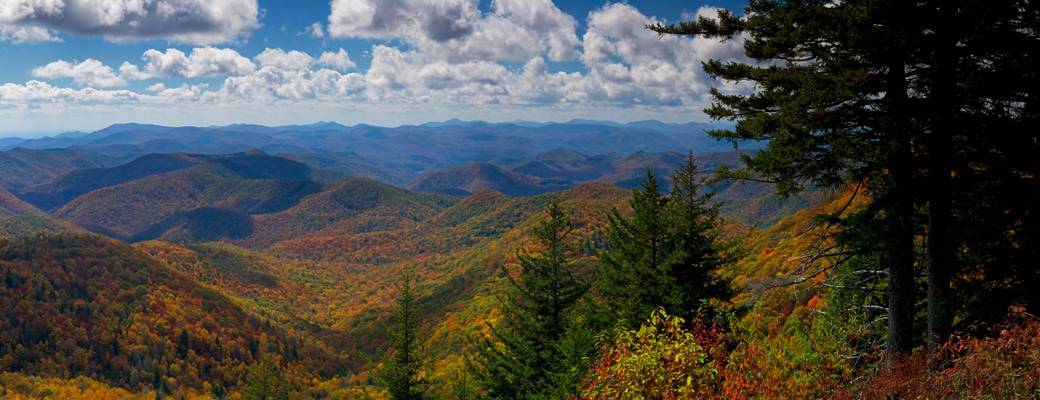
by Michael Kight
Here’s the scene you’re greeted with at the Wolf Mountain Overlook at mile marker 424.8 on the Blue Ridge Parkway. While there are quite a few wide-open spaces along the Blue Ridge Parkway, this one is among my favorites. I had my camera set up on the tripod and waited out the light as an overcast and rainy sky broke up into this low scud. This overlook is covered somewhat by the balsam firs you see on the right, and a stone wall on the left (that first step is a doozy without it). Many people merely drive by without knowing what lies beyond that wall… get out and look people! I’ve found that the tripod often becomes a magnet, as people want to see what interests the photographer. Back when I shot film from my Mamiya RZ 67 “Professional S” camera, I had a busload of people surround me at Clingman’s Dome, when some woman from within the crowd said, “Stand back everyone! He’s a professional… he knows what he’s doing.” I nearly died laughing. While I do what I can to approach photography in a professional way, she was reading the camera, not me.
At this scene, an older couple did stop and walked up to see what I was seeing. This woman made a more sensible comment, “It looks just like a patchwork quilt!” She was right.
Wolf Mountain is actually in the distance near that bit of water seen near the middle of the image… that’s Wolf Lake. The area was so named because it was once the last stronghold for wolves in the Carolinas. This area was home to buffalo and elk, too, until they were totally hunted out around 1850. That left hogs and sheep to replace them on the wolf menu, prompting farmers to exterminate the wolves too.
In recent years, both wolf and elk have been reintroduced to these mountains. I’ve seen wolves early, early (0’ dark-thirty) in the morning crossing the road at a farm near Julian Price Park… I had to stop as they ran by in the headlights. The elk still eludes me.
This is a true panoramic of seven vertical images stitched together in Photoshop. The original file is 72"x27". Best viewed large, against black, with salsa and chips... hey, that's just how I roll.
Thanks to all Phoide contributors to Appalachian Mountains!
Most notably Michael Kight, George Kurzik, Sandeep Thomas, Andrey Sulitskiy and Jacques B. Geoffroy.
